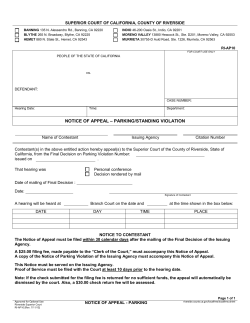
Today: How are ads persuasive? What techniques are used and why?
Today: How are ads persuasive? What techniques are used and why? Defining Some of Advertising Persuasive techniques • different ways to persuade the audience • influence people to have a certain belief or opinion or to act in a certain way. • used to convince people to buy a product or service or adopt an idea. • aim messages at the audience’s emotions, beliefs, or reason. Details about techniques in ads Advertisers use a combination of visuals, sound, special effects, and words to persuade their target audience. Every ad contains a “message” or big idea. Messages center around three types of “appeals”: emotional, logical, and ethical. Defining Some of Advertising Logical appeals: persuasive techniques that rely on facts and reason. The claim makes sense. Problem and solution may be used. Defining Some of Advertising Ethical appeals are persuasive techniques that link claims to already accepted values and beliefs. Sometimes unethical, depending on how used. Defining Some of Advertising Emotional appeals are persuasive techniques that tap into strong feelings, such as appeals to fear, pity, guilt, happiness. Emotions are evoked through loaded words, images, music, and colors. Ethical Appeal + Emotional Appeal: Guilt Emotional Appeal: Relaxation Emotional Appeal: Sadness Loaded Terms/Emotional Appeal: Love, Heaven Emotional Appeal: Guilt IMPORTANT: Emotional, logical, and ethical appeals may overlap. Persuasive Technique How It Is Used Intended Effect Humor (Emotional Appeal) Makes the consumer laugh; often gives little information about the product • Consumers remember the ad and the product. Persuasive Technique How It Is Used Intended Effect Bandwagon Suggests that everyone is using the product • Consumers buy the product because they want to fit in. • Consumers assume that if others buy it, the product must be good. (Emotional Appeal: envy, being left out) Bandwagon Bandwagon Bandwagon Bandwagon: Discount Bandwagon: Action required! Persuasive Technique How It Is Used Intended Effect Appeals to • Consumers consumers’ desire celebrate their (Logical + Emotional to be different from own style, or Appeal) everyone else; the rebel against opposite of the what others are bandwagon appeal doing. • Consumers think of the product as different, fashionable, or cool. Individuality Individuality Individuality Individuality Individuality Individuality Persuasive Technique How It Is Used Intended Effect Shows a popular • Transfer respect celebrity promoting or admiration of a product celebrity to product (Logical + Emotional • Think of celebrity Appeal: Admiration – think of product + Trust) Testimonial: Celebrity Spokesperson Testimonial (Celebrity) Testimonial (Celebrity) Testimonial (Celebrity) Testimonial (Celebrity) Testimonial (Celebrity) Testimonial (Celebrity) Testimonial (Celebrity) Persuasive Technique How It Is Used Intended Effect Testimonial: Expert (Appeal to Logic) Shows an expert or an authority figure who says they recommend the product. • transfer trust of the expert to the product. (Ex. dentist or doctor) Testimonial (Expert) Testimonial (Expert) Persuasive Technique Loaded Terms (Words) #1 “Glittering Generalities” (Emotional Appeal) How It Is Used Intended Effect Uses vague words – • Consumers accept such as patriotism this information, and family – that often without bring to mind values questioning why people agree with; no evidence was often provides little given to support or no concrete the claim. evidence Loaded Terms: Glittering Generalities Persuasive Technique How It Is Used Loaded Terms #2 Uses words that “Purr Words” (Emotional Appeal) have positive feelings associated with them, such as “tasty,” “maximize,” “live,” or “sensational.” Intended Effect • product seems more desirable. • Appeal to emotions, rather than their logic. Loaded Terms: Purrrrrrrr Loaded Terms: Purrrrrrrr Loaded Terms: Purrrrr Persuasive Technique How It Is Used Intended Effect Repetition words, images, or • remember the phrases shown over words, etc. and and over again associate them with the product Slogans or jingles Persuasive Technique Plain Folks (Normal People) Logical Appeal How It Is Used Intended Effect everyday people used to connect to normal people like you and me. • Consumers draw a parallel between themselves and the everyday person using a product. Ex. Families, moms, kids, athletes. Plain Folks Plain Folks Plain Folks Plain Folks Plain Folks Plain Folks Persuasive Technique How It Is Used Snob Appeal Taps into people’s • Consumers desires to be special associate being or part of an elite special or elite group with the product, service, or idea. (Emotional Appeal: envy) Intended Effect Snob Appeal Snob Appeal Snob Appeal Snob Appeal Persuasive Technique How It Is Used Intended Effect Name-calling (product comparison) The negative aspects of a competitor are highlighted. ____ vs. ____ • develop a negative opinion of a competitor’s product and buy the sponsor’s product instead. Logical Appeal Name-calling Name-calling Name-calling Name-calling Name-calling Name-calling What’s the author’s purpose of every single advertisement ever made? TO PERSUADE. Target Audience A target audience is the specific group of people that a product is aimed at. Advertisers draw s between members of a target audience. They look for shared characteristics, such as age, gender, ethnic background, occupation, geography, values, or lifestyle.
© Copyright 2025












